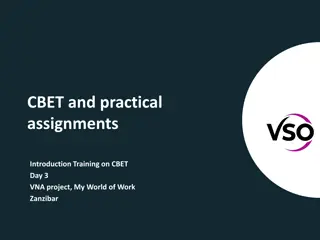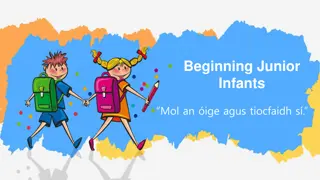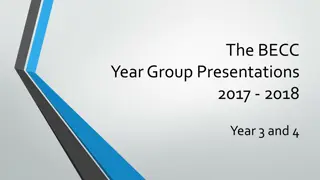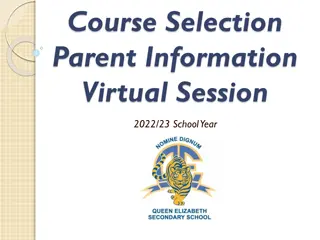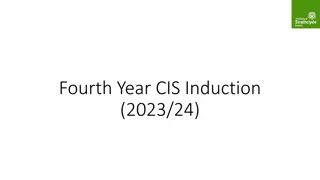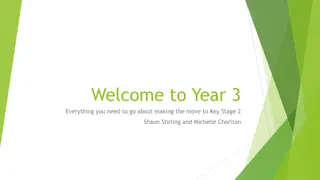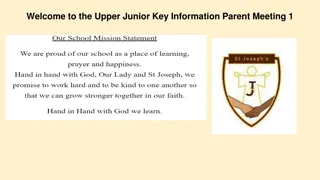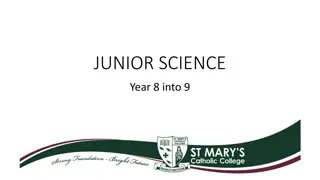Welcome to Year 5 Practical Information
Ensure your child is prepared for Year 5 with important practical details such as uniform requirements, drop-off and pick-up procedures, daily timetable, and PE considerations. Stay informed about school policies and be involved in promoting positive behavior for a successful school year.
Uploaded on Sep 27, 2024 | 0 Views
Download Presentation

Please find below an Image/Link to download the presentation.
The content on the website is provided AS IS for your information and personal use only. It may not be sold, licensed, or shared on other websites without obtaining consent from the author.If you encounter any issues during the download, it is possible that the publisher has removed the file from their server.
You are allowed to download the files provided on this website for personal or commercial use, subject to the condition that they are used lawfully. All files are the property of their respective owners.
The content on the website is provided AS IS for your information and personal use only. It may not be sold, licensed, or shared on other websites without obtaining consent from the author.
E N D
Presentation Transcript
Welcome Year 5
Welcome to Year 5. Staff Teacher/s: Mrs Shrewsbury/Mrs Parry/ Mr Cross Teaching Assistant: Mrs Swales Family Support Worker: Mrs Coulson
Practicalities Your child should be wearing summer uniform until half term. If you haven t already done so, please label all of your child s uniform. Your child should have a waterproof coat with a hood in school. Packed lunch boxes should be labelled. All children should have a named water bottle which contains only water. Break times - KS2 pupils can buy fruit at the Junior Snack Bar (for 20p-40p) and toast is available on a Friday.
Practicalities continued If someone different is picking your child up, please phone the office in advance so that they can inform their class teacher. School starts at 8.55am. The gate and classroom doors open at 8.45am. Please drop your child off at the outside door. If your child is late they must enter school via the office and a late form completed by an adult. School finishes at 3.15pm.
Daily timetable in Year 5. 8.45- 9.00 Session 1 Session 2 Afternoon Maths activity Word activity Maths Worship Worship Maths Maths Prayer and Praise Reading/ Quizzing Reading/ Quizzing Computing PE RE Spellings Monday English Tuesday English LUNCHTIME PLAYTIME Silent Reading History Handwriting Reading/ Quizzing DT MFL Wednesday Writing to stimulus Maths Reading/ Quizzing Art Thursday English Class worship Geography Art Maths Worship English Music Reading/ Quizzing Science PE Friday activity
P.E. In Year 5, your child will have P.E on Mondays and Fridays . Please ensure that they come dressed in P.E kit on these days. Jewellery must not be worn for PE (earrings must be covered with plasters or taken out by the child) Long hair must be tied back during school and all P.E lessons (only plain navy or blue hairbands are acceptable).
Behaviour A copy of our behaviour policy is available on our website (this will be updated this term). It is important that we work together as a partnership and that you understand how behaviour issues are dealt with at school. At St Chad s we promote positive behaviour throughout and we have many positive reinforcements in place. For example in Year 5, we reward with marbles and praise cards. All children receive house points. Children are also chosen for Star Of The Week and Learner Of the Week Awards. Our Head Boy and Girl and our Deputy Head Boy and Girl promote positive behaviour.
Behaviour Continued If your child demonstrates poor behaviour in class, they will be given a warning. If they have to be spoken to again, then their name will be placed/written on the board. If their behaviour issues continue, then they will miss 10 minutes of their playtime. If there are issues on the yard or persistent refusals to co-operate , children have time out on the fence.
Parent Partnership Reading We expect that your child reads each night. Please sign their new planner as soon as you have listened to them read so that we know whether they are having any difficulties and please send it into school each day. Comprehension skills are very important. Please discuss your child s reading book with them and ask quiz questions about the text they have read. Our aim is to promote a love of reading!
Home Learning Your child will receive home learning each week for English and Maths. It is very important that homework is completed and returned on the day requested so that it can be marked and returned with their next homework. In Year 5, spellings are given on Tuesdays. At the start of the year, your child will be issued with login details for Seesaw, Power Maths, Purple Mash and Accelerated Reading. Please keep these safe and let us know asap if you are having difficulties logging on. If you have any problems with accessing technology please let us know straight away.
Expected Outcomes for Year 5 in Reading Use suffixes to understand meanings e.g. -ant, - ance, - ancy, -ent, ence, -ency, -ible, -able, -ibly, - ably. Read and understand meaning of words on Y5/6 word list. Use punctuation to determine intonation and expression when reading aloud to a range of audiences. Explore themes within and across texts. Analyse the conventions of different types of writing. Check that the book makes sense to them and demonstrating understanding.
Expected Outcomes for Year 5 in Reading Demonstrate active reading strategies. Infer characters feelings, thoughts and motives from their actions and justifying inferences with evidence. Predict what might happen from information stated and implied. Re-read and read ahead to locate clues to support understanding. Scan for key words and text marking to locate key information. Summarise main ideas drawn from more than one paragraph and identifying key details which support this. Identify how language, structure and presentation contribute to meaning. Explain the effect on the reader of the authors choice of language. Distinguish between statements of fact or opinion within a text. Justify opinions and elaborating by referring to the text. (Point + Evidence + Explanation).
Expected Outcomes for Year 5 in Writing Create complex sentences by using relative clauses with pronouns who, which, where, whose, when, that Create and punctuate complex sentences using a variety of openers Use devices (pronouns, conjunctions, etc) to build cohesion within a paragraph Identify and use brackets and dashes Using organisation and presentational devices Use vocabulary and punctuation to enhance effects and clarify meaning.
Expected Outcomes for Year 5 in Writing Ensuring consistent and correct use of tense throughout a piece of writing. Proofreading for spelling and punctuation errors Use dictionaries and thesaurus to check the spelling and meaning of words. Spell most words containing Y5 spelling patterns/rules correctly. Maintain legibility in joined handwriting when writing at speed.
Expected Outcomes for Year 5 in Maths I can read and write numbers to 100,000 and identify the value of the digits. I can add multiples of 1, 10, 100, 1000 and 10,000 within 100,000 I can choose the correct operation and an appropriate strategy to + and using knowledge of numbers to 100 and 1000. I know that 10 tenths are equivalent to 1 one and that 1 is 10 times the size of 0.1. I know that 100 hundredths are equivalent to 1 one and that 1 is 100 times the size of 0.01 I recognise the place value of each digit in numbers with up to 2 decimal places, and compose and decompose numbers with up to 2 decimal places using standard and non-standard partitioning.
Expected Outcomes for Year 5 in Maths (cont.) I can reason about the location of any number with up to 2 decimals places in the linear number system, including identifying the previous and next multiple of 1 and 0.1 and rounding to the nearest of each. I can divide 1 into 2, 4, 5 and 10 equal parts, and read scales/number lines marked in units of 1 with 2, 4, 5 and 10 equal parts. I can convert between units of measure, including using common decimals and fractions. I can multiply any whole number with up to 4 digits by any one- digit number using a formal written method.
Expected Outcomes for Year 5 in Maths (cont.) Secure fluency in multiplication table facts, and corresponding division facts, through continued practice. I can apply place-value knowledge to known additive and multiplicative number facts (scaling facts by 1 tenth or 1 hundredth). I can multiply and divide numbers by 10 and 100; understand this as equivalent to making a number 10 or 100 times the size, or 1 tenth or 1 hundredth times the size. I can find factors and multiples of positive whole numbers, including common factors and common multiples, and express a given number as a product of 2 or 3 factors.
Expected Outcomes for Year 5 in Maths (cont.) I can divide a number with up to 4 digits by a one-digit number using a formal written method, and interpret remainders appropriately for the context. I can find equivalent fractions and understand that they have the same value and the same position in the linear number system. I can recall decimal fraction equivalents for , I can compare angles, estimate and measure angles in degrees ( ) and draw angles of a given size. I can compare areas and calculate the area of rectangles (including squares) using standard units.
Statutory Tests Year 1 Year 2 There are no statutory tests in Y3/Y5 but we will be beginning to prepare for the SATS at the end of KS2. Year 4 Year 6
KS2 Marking Policy Our full marking policy can be found on our website Symbol Meaning Objective Achieved A Objective almost Achieved A- Objective not achieved * Try spelling this word again ____sp Does not make sense/ meaning is unclear ? Find and include the missing punctuation on this line P A new paragraph is needed // Speech marks are missing or used incorrectly. A word or letter has been missed out ^ Error to be checked Correct . Incorrect Amazing! Next step VF Verbal Feedback
Reporting to Parents Autumn Term Parent s Evening- Monday 17th and Thursday 20th October 2022 Spring Term Parent s Evening- Tuesday 7th and Thursday 9th February 2023 End of Year Reports Friday 14th July 2023
Open door policy St Chad s operates an open door policy. If you have an issue or concern, please discuss it firstly with the class teacher. First thing in the morning when the door is opened or when the teacher is seeing the children out at the end of day, is not always the most convenient time to discuss serious concerns. You can call the office to make an appointment to see the class teacher or ask for a call back. A quick message to the teacher via email is fine. However, we prefer not to communicate via email over serious issues or concerns - these are always best dealt with in person or over the phone. In the rare event that the matter cannot be resolved with the teacher, please contact Mrs Bitsakaki.
Thank You Any questions? LOVE LEARNING. LOVE GOD. LOVE ONE ANOTHER.




